Cultivating an Urban, Sustainable Amazonia in Colombia
September 7, 2023
By: Marco Herndon, ESI Biodiversity and Cities Summer Fellow
Leticia — Colombia’s southernmost city in the Amazon — shares a border between Brazil and Peru along the Amazon River. It’s common to hear Portuguese on the streets and eat Peruvian ceviche for lunch.
Due to its strategic location in one of the most biodiverse ecosystems on the planet, and as a strategic natural carbon sink, Leticia was selected as a case study for the DUSP (Department of Urban Studies and Planning) 2023 Spring practicum titled “Biodiversity and Cities: A Perspective in Colombian Cities.”
This course was co-taught between MIT professors Gabriela Carolini and John E. Fernandez, with ESI’s Research Program Director Marcela Ángel, ESI’s Postdoctoral Associate Norhan Bayomi, and PhD candidate Alessandra Fabbri. They worked in partnership with Luz Marina Mantilla, the Director of Colombia’s Amazonian Research Institute SINCHI, and Juan Felipe Guhl, the Director of the Socio-Environmental Dynamics Group at SINCHI.
The research-oriented class centered on improving biodiversity management through urban development strategies for cities participating in Colombia’s Bio-diverse and Resilient Cities Program (formerly known as Biodivercities prior to 2023).
Building on the work of the class, Marco Herndon and Patricia Garcia (both MCP ‘24), dedicated their summers to engaging with stakeholders in Leticia and presenting the recommendations generated during the course, actively contributing to the process of charting the implementation of some of these proposals.
The practicum owes its success to the ongoing partnership with SINCHI, who played a pivotal role as a vital research collaborator of ESI. SINCHI was deeply involved in the design and implementation of the research agenda for the class, instrumental in opening spaces for dialogue with local communities and creating enriching platforms for discussions, and was able to provide valuable insights that enhanced the students’ efforts throughout the semester and the summer fellowship.
A unique, interdisciplinary practicum
Students developed their ideas through a collaborative and multidisciplinary endeavor, with participants hailing from various parts of the world and representing a range of disciplines including architecture, urban planning, and computer science. This mix of disciplines allowed students to balance design proposals with practical, policy recommendations attentive to the idea of Leticia as a single urban system.
To formulate their ideas, the students relied on a multifaceted approach, combining on-the-ground observations from a field-trip conducted in January 2023 with insights drawn from scholarly work conducted by leading researchers on urban biodiversity management.
“The stakeholders in the city were exceptionally open in sharing their experiences and efforts over the years, which inspired our work,” reflected Garcia, with regard to how the practicum provided a unique opportunity to observe diverse perspectives in the urban environment of Leticia.
The students were able to benefit from the profound expertise, extensive knowledge base, and set of strong relationships developed by SINCHI over the past few decades. Through virtual meetings and the exchange of resources, SINCHI laid a robust groundwork for the class, sharing comprehensive insights of Leticia’s urban and biodiversity dynamics, and elucidating potential paths for its future development.
Throughout the semester, students challenged one another to offer both practical and innovative recommendations. They were able to test and validate their ideas through ongoing discussions with SINCHI, which was essential to strengthening them. Their primary focus was on developing strategies that could harness the potential of Leticia’s emerging tourism industry to contribute to biodiversity conservation within a context of local economic development and equity, particularly acknowledging the role of indigenous communities in Leticia and its surrounding areas.
While recognizing their roles as foreign researchers, the class introduced novel ideas that were grounded in the local priorities and the ongoing local initiatives to protect biodiversity. This approach led them to craft a comprehensive set of urban planning strategies that were anchored in three fundamental principles: conservation, inclusion, and feasibility. Some of these strategies included participatory planning, incentivising bioeconomic practices, and urban habitat restoration.
The students further applied their recommendations to envision scenarios for the market and civil port of Leticia, focusing on practical solutions for these areas.
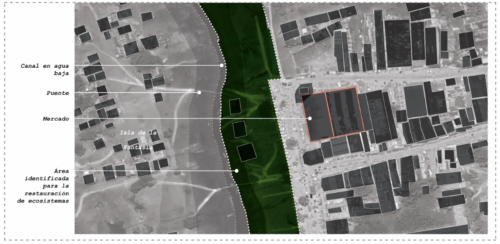
Map of civil port and market area in Leticia. Image credit: Courage Dzidula Kpodo (MIT ‘25)
The market and civil port of Leticia holds cultural and bioeconomic significance, acting as a central hub within the city for the commercialization of indigenous produce. It has the potential to attract tourists with a variety of local food.
The student’s recommendations for this site included:
- Establishing a community-based organization to facilitate participatory planning processes involving food vendors and indigenous producers. Through this approach, community-based ideas for the market plaza’s redesign could be generated, ensuring that the project aligns with the needs and aspirations of the local vendors and indigenous communities who live in the outskirts of Leticia and sell their produce in the market.
- Increasing awareness of the local bio-economy and creating incentives to encourage the adoption of green business practices and the cultivation of a circular economy in the area.
- Ecological landscape restoration to enhance the site’s ecosystem services, including flood mitigation, water filtration, and temperature control, among others.
Further details on the full list of recommendations and potential steps for implementation, as well as a complete diagnostic, are available as a full report.
Following the conclusion of the class, Herndon and Garcia took further steps to ensure its accessibility by translating the final report and executive summary to Spanish.
Returning to Colombia
This past June, Herndon and Ángel returned to Leticia to share the findings of the class. In her capacity as program director and co-instructor, Ángel has fostered a multi-year engagement with key players such as the Ministry of Environment and Sustainable Development of Colombia, as well as SINCHI and the Municipality of Leticia. Through SINCHI, the partners were able to convene with local community groups and other local academic and government actors, facilitating a vital exchange of feedback and insights from stakeholders, which enhanced the depth and breadth of recommendations for the implementation phase.
Starting their visit in Bogotá, Ángel, Herndon, Luz Marina Mantilla (Director of SINCHI), and Juan Felipe Guhl (Director of the Socio-Environmental Dynamics Group at SINCHI), met with The Head of the Bio-diverse and Resilient Cities Program at the Ministry of Environment, Adriana Solano-P., for a fruitful conversation.
Solano-P. stressed the importance of an intervention-based approach, combining bioeconomic strategies with restoration efforts and urban redevelopment plans. She also praised the focus on the market plaza and port area, recognizing its significance as a hub not only for Leticia’s residents, but also for the daily influx of international visitors from Peru and Brazil.
Furthermore, Solano-P emphasized the importance of the national Bio-diverse and Resilient Cities Program, praising the ways that it sought “to re-establish the connection between cities and their natural environments, so urban centers [were] not only tools for social and economic development, but also important spaces for the conservation and the sustainable use of biodiversity.” Looking forward, she added, “Our hope is to incorporate this natural richness into the social and economic development of cities as well as benefit ecological connectivity processes between the urban and the rural to help close gaps.”
Onward to Leticia, the group was joined by Guhl. Guhl, as a thought partner from the inception of the class, provided ample feedback to strengthen the class’ proposal and generously shared his deep expertise about Leticia, its socio-cultural dynamics, and its history of urbanization. Moreover, SINCHI’s well-regarded reputation in Leticia as an effective government actor made it possible for MIT’s researchers to engage in meaningful conversations facilitated by Guhl, who also provided valuable contextual knowledge as well as pragmatic recommendations to make these conversations more fruitful.
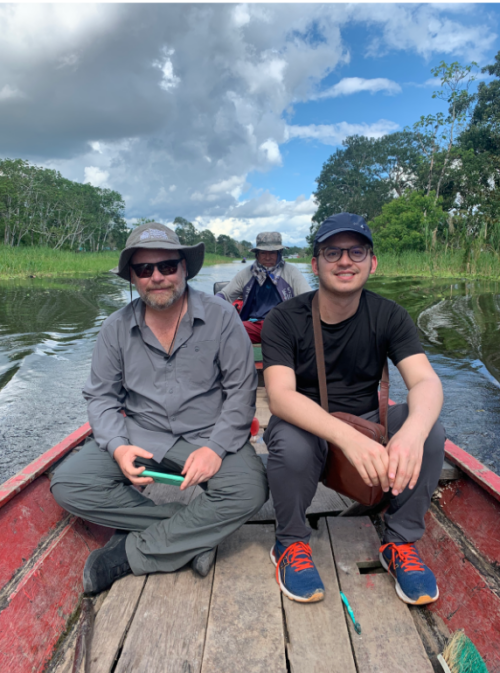
Juan Felipe Guhl (SINCHI Institute) and Marco Herndon (MCP’24) on a boat traveling through the Amazon River. Photo credit: Marcela Ángel
During the discussions in Leticia, the group learned that the city had started discussions about renovating the market plaza and port area to improve health and sanitary conditions, making the student’s recommendations warmly welcomed.
As Fernanda Pérez, Municipal Planning Advisor of Leticia, expressed, “We’re very interested in the development of innovative solutions that, acknowledging the socioeconomic reality of the municipality, allow us to advance the development of a bio-sustainable world. We cannot face these challenges alone as a city, and count on support at the national level and through alliances like this one with institutions like MIT.”
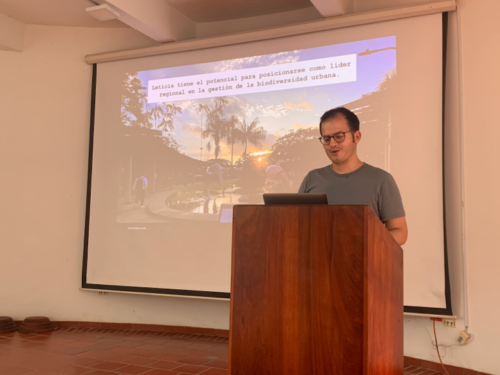
Marco Herndon (MCP’24) presents at SINCHI Institute in Leticia, Colombia. Photo credit: Marcela Angel
What stood out the most from these discussions, however, was the evident enthusiasm and interest from the public and key local stakeholders regarding the proposals. The group witnessed how their visit had sparked meaningful conversations about the future of Leticia and a real hope for a more harmonious relationship with the surrounding environment. The participants at the public forum engaged in lively debates, reflecting on the city’s preliminary efforts in redeveloping the market plaza and addressing the complexities of biodiversity conservation. These debates showcased a genuine interest not only to grapple with the students’ ideas and recommendations, but also to collaboratively chart a viable path forward for their implementation.
As Guhl observed, the visit was a rare opportunity for a university to “engage in timely and on-going conversations with a robust framework and specific ideas.”
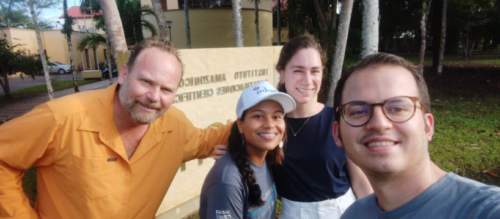
Team members gather. From left to right: Juan Felipe Guhl (SINCHI Institute), Maylin Martinez (a local high school student in Leticia), Marcela Ángel (ESI Research Program Director), and Marco Herndon (MCP’24). Photo credit: Marco Herndon
At the end of their visit, Ángel, Herndon, and Guhl took a brief trip to the Yahuarkaka Lakes.
“A journey along the water just minutes away from the city is a powerful reminder of what’s at stake in finding new pathways for urban development for cities in biodiversity hotspots, and in the case of Leticia, to protect the Amazon’s cultural and biological diversity,” commented Ángel, while the group traveled by riverboat through rain and blazing sunlight, observing the wide array of birds, trees, and human settlements patterns unique to that part of the Amazon.
Find the Spanish-language final report and executive summary, alongside the class report in English, on the publications page of the ESI website.
The ESI’s Rapid Response Group Engages Climate Justice Issues in the Snake River Region
September 2, 2023
By: Ty Rogers, ESI Intern and Briana Meier, Postdoctoral Associate
This summer, following the the ESI Climate Justice Program team’s visit to San Juan Island in April to meet with project partners at the Indigenous-led nonprofit Se’Si’Le, we organized a student research project in support of Se’Si’Le’s efforts to restore Pacific salmon and orca populations, and advocate for tribal-led conservation in the Pacific Northwest. We recruited undergraduate student researchers through the ESI Rapid Response Group (RRG), which is an ongoing ESI initiative formed to respond to critical environmental issues in a timely manner with science-based analysis and assistance in service to ESI’s partners.
From June through August, five RRG students investigated urgent issues around the lower Snake River dams, Pacific salmon and orca recovery, and tribal sovereignty. During these months, negotiations have been underway to settle a federal lawsuit filed in 2020 by the Nez Perce tribe, other tribes, and a coalition of conservation organizations. On Aug. 31, a “stay in litigation” was extended for another 60 days, meaning that the parties to the lawsuit have until the end of October to come to an agreement. At the time of publication, no announcement has been made about extending the federal public comment period, but it may be reopened through October.
Se’Si’Le Executive Director Dr. Kurt Russo explained the significance of the issues.
“These efforts are about calling for a free-flowing Snake River and bringing attention to the interconnection of salmon, orca, and Indigenous peoples of the region,” he said. “There’s a moral obligation here, an existential threat to Indigenous lifeways. It’s not just a matter of what they do for a living — it’s what living means.”
In recognition of the extensive scientific research and policy work already available on the technical, economic, and social impacts of the four lower Snake River dams, students focused their efforts on their own analyses of the ethical and economical issues related to proposals to remove or breach the dams, and on communications strategies that could make engage broader publics in these issues.
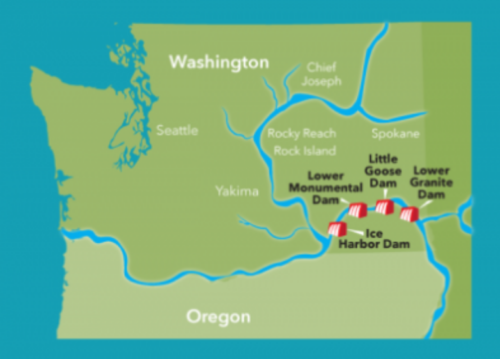
Figure 1: A map showing the locations of the four Lower Snake River dams. Photo credit: Columbia River Keeper
The four Lower Snake River dams (see Figure 1) were constructed in the late 1960’s and early 1970’s for several reasons, including flood control, navigation, irrigation, recreation, transport of goods, and hydropower. However, activists and local tribes have long voiced their concerns about the negative ecological and cultural impact of the dams. Threatened and endangered Chinook, sockeye, and sockeye populations have continued to decline over the years in part due to challenges presented by the dams. The decline in salmon populations impacts other species, including the endangered Southern Resident Killer Whales that depend on these fish for survival.
Indigenous nations of the region, including the Nez Perce, Yakama, Umatilla, Lummi, and others, hold deep cultural and spiritual connections with salmon and orca. These and other tribes call themselves the Salmon People, and their cultures are inseparably intertwined with salmon. Therefore, the lower Snake River dams are not just negatively impacting the salmon, orcas, and other species, but also Indigenous cultural identities.
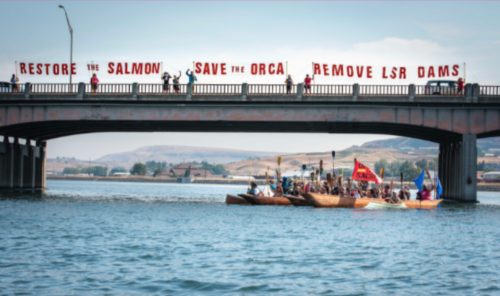
Protestors on canoes and a bridge above the Clearwater River before it meets the Snake River during the Free The Snake Flotilla Demonstration in 2018. Photo Credit: Mike Beiser/AP via Northwest Public Broadcasting
Snake River Climate Justice Rapid Response Group Projects
Bethany Costanzo, an ESI intern and third-year environmental and sustainability sciences student at Northeastern University, studied the history of tribal rights and tribal sovereignty in the Snake River region. She wrote an op-ed piece from the perspective of a person with colonizer ancestry that called for settlers to acknowledge their moral obligation to join tribes in their fight for dam removal. In her op-ed, she argued, “All indigenous peoples have the right to decide how to conserve their environment and preserve their culture, and [settlers] have a moral obligation to uphold these rights.” Bethany submitted her essay as an op-ed to The Seattle Times and to the Council on Environmental Quality during its most recent public comment period.
To support public understanding of these issues, Savannah Ashley, a third-year computer science and molecular biology student at MIT, produced a visually accessible timeline outlining key moments in the policy and legislation history of the dams. We have shared this visual timeline with our partners at Washington State Sierra Club in support of their outreach efforts.
Those opposed to breaching the dams are concerned about the potential negative impact on the regional economy and particularly on agricultural sectors. Elizabeth Kim, a second-year economics student at Wellesley College, addressed these concerns in an essay on the economic benefits that dam removal could bring to this area. Elizabeth argued for the potential of increased tourism from enhancing recreational activities, as well as the potential to save federal money on dam maintenance and repairs that could instead be used for improving other infrastructure projects.
Ty Rogers, an ESI intern and a fourth-year environmental studies student at Northeastern University, focused on the impact that breaching the dams would have on agriculture. Farmers in the area rely on barge transport to move their crops, but if the dams were breached, barge transport would no longer be feasible. If improvements were made to already existing rail tracks and train loading facilities in the area, rail transport could help to reduce truck miles, lower transportation costs, and reduce associated social costs such as greenhouse gas emissions and damage to public roadways. Ty worked with Solutionary Rail to create an infographic that clearly and concisely explains the issue, as well as possible solutions. Solutionary Rail advocates for investments to be made to improve rail systems in southeast Washington and improve infrastructure resilience.
Kelly Hong, a second-year computer science and engineering student at MIT, developed a website to showcase the Snake River Climate Justice Group’s work. The website provides a platform for these projects to spark conversations for the removal of the Lower Snake River dams and a resource for our project partners.
We thank our project partners, Se’Si’Le, the Washington State Sierra Club, and Solutionary Rail, for mentoring the ESI Snake River Climate Justice Group this summer. We look forward to further work with our project partners.
What’s Next
In late September, Se’Si’Le will lead the 2023 All Our Relations Snake River Campaign throughout Washington, Oregon, and Idaho. The campaign will launch in the midst of the newly extended federal litigation negotiation period, and campaign leaders hope that the series of planned events throughout the region will increase public involvement in the work to restore salmon populations. Event dates and details are available here.
For More Information
Contact the ESI’s Climate Justice Program Lead, Postdoctoral Associate Briana Meier, for more information about this work and the ESI’s Climate Justice Program: bkmeier@mit.edu.
MIT Climate Machine at the Gorge Amphitheater
August 9, 2023
by Norhan Bayomi, Postdoctoral Fellow
From July 21-23, the MIT Climate Machine and a research group of five undergraduate students under the Rapid Response Group (RRG) deployed an innovative climate engagement program during Group Therapy Weekender, the electronic music festival at the Gorge Amphitheater in Washington state. The goal was to raise awareness of pressing climate issues through interactive and creative experiences tailored to the festival context and attendees. The program included a set of interactive and immersive experiences designed and developed by the Climate Machine team and the RRG students, including augmented reality, projection mapping, an arts and crafts workshop, and a virtual reality exhibition.
A major program component was an augmented reality (AR) experience themed as a scavenger hunt game, leading participants to find climate-themed AR exhibits on a journey through different locations in the festival venue. This gamified experience provided visualizations about climate topics like emission reduction, waste management, biodiversity conservation, social justice, and energy conservation in an engaging way. Players could scan QR codes to activate 3D models and explore various climate-themed multimedia content.

A player scans a QR code as part of the augmented reality (AR) experience.
The team also set up an immersive virtual reality (VR) exhibition that envisioned a future scenario for the Gorge due to climate change, where attendees designed specific changes to the surrounding environment to mitigate climate change effects.
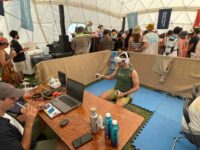
An attendee participates in the virtual reality (VR) exhibition.
In the Climate Defender arts workshop, festivalgoers reflected on their relationship with nature by creating art using multimedia collages. The RRG students were integral to the project development and deployment at the Gorge.
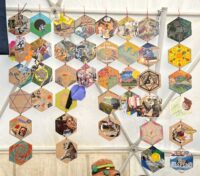
A multimedia collage created by festivalgoers.
In addition, MIT Climate Machine designed and deployed an audio-reactive projection mapping experience called Climate Canvas. During this experience, interactive 3D visuals were used to visualize Washington state’s rich biodiversity, from orca whales to temperate rainforests. The visually engaging display reacted in real time to the music played on one of the Gorge stages.

Panelists gather. From left to right: John Fernandez, Steve Heaver, Annie Norman, and Dave Dresden.
Finally, there was a panel discussion led by MIT Professor John Fernandez with Steve Heaver of Involved Group, Annie Norman of Anjuna, and musician Dave Dresden from electronic duo Gabriel and Dresden. The panel discussed opportunities to make music festivals more environmentally friendly and what role the festival attendees can play. The panelists also discussed ways to inspire positive climate action among festivalgoers through initiatives like the MIT Climate Machine program.
AIFCC at the UN Permanent Forum on People of African Descent
July 26, 2023
June 2023 marked the second session of the United Nations Permanent Forum on People of African Descent (UNPFPAD) in New York City. The session’s programming included a side-event and landmark gathering for the Afro-Interamerican Forum on Climate Change (AIFCC) with over 90 prominent researchers, activists, and representatives hailing from Ecuador, Peru, Honduras, Nicaragua, Brazil, and the Garifuna people. This event, organized by the AIFCC and convened by the Ambassador of Colombia in the United States, Luis Gilberto Murillo, focused on the pressing socio-ecological and systemic racism challenges faced by Afro-descendant communities that serve as historic environmental stewards across the Americas.
Launched at the 26th UN Framework Convention on Climate Change (COP26) in 2021, and hosted at the MIT ESI and in partnership with Conservation International, the AIFCC conducts research, brings greater visibility to, and strengthens technical capacities of Afro-descendant populations in their efforts to address the interconnected crisis of climate change and biodiversity loss, supporting their ground-breaking contributions to the stewardship of areas of critical environmental importance and their global environmental services.
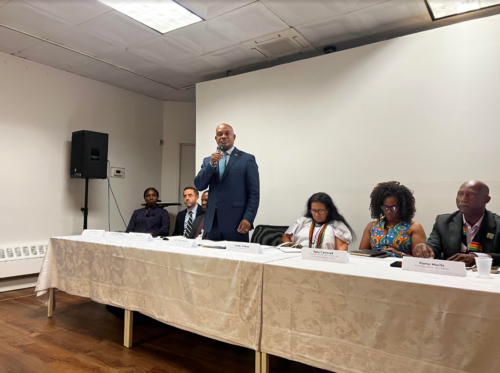
Opening remarks by Luis Gilberto Murillo, Colombian Ambassador to the US and former MLK fellow at ESI.
The event this June, titled “Climate Change and Biodiversity Loss: Challenges and Opportunities for Afro-descendant Communities as Crucial Environmental Defenders,” served as a platform for sharing valuable insights between board members of the UNPFPAD, global political leaders and researchers invested in finding solutions to the aforementioned socio-environmental challenges. Featured speakers included Epsy Campbell, President of the UNPFPAD; Amara Enyia, Member of the UNPFPAD and President of Global Black; Kelvin Alie, Senior Vice President for Field Partnerships in the Global Field Programs at Conservation International; Andrés Mejía, General Consul of Colombia in New York; Pastor Murillo, Member of the UNPFPAD; Angelica Mayolo and Marcela Ángel from the MIT Environmental Solutions Initiative and the AIFCC; and Julio Guity-Guevara, member of the AIFCC’s Coordinating Committee and Managing Director at SUDECC.
The urgent need for financing Afro-descendant, community-led natural climate solutions was emphasized by the panelists. They stressed that the challenges faced by these communities demand robust financial support to implement sustainable solutions, protect their lands, and promote environmental justice, and that without adequate resources, the aspirations and efforts of Afro-descendant communities as environmental stewards may be hindered.
Furthermore, the need for more significant participation of local Afro-descendant leaders from across the Americas in key international platforms, such as the upcoming COP28 in 2023 was highlighted. Participants were committed to facilitating these processes from within different organizations with the objective of amplifying the unique perspectives, lived experiences, and valuable insights of these communities in decision-making processes that shape environmental policies and strategies worldwide. “By amplifying the voices of Afro-descendant leaders, we can foster a more inclusive and comprehensive approach to environmental governance,” said Angelica Mayolo, incoming MLK scholar at ESI.
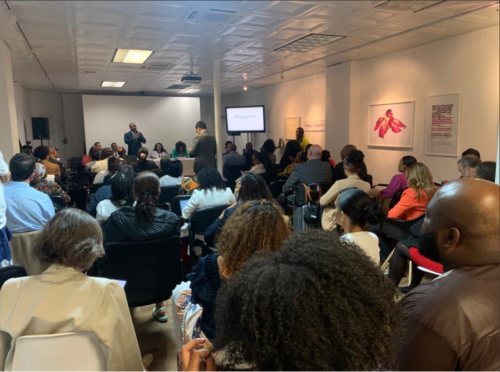
Over 90 researchers, activists and government representatives from across the Americas attended the UNPFPAD side-event at the US consulate in NY
Mayolo and Angel further outlined ways in which ESI and the AIFCC have been working to respond to these demands, including the need to leverage research to inform policy and local actions, to create spaces for greater participation and visibility of Afro-descendant leaders, and to support community-based innovation in Natural Climate Solutions. “We’re working on creating a pipeline of community-based Natural Climate Solutions, providing technical assistance and training in the design and formulation of projects with local Afro-descendant communities,” explained Mayolo. Angel pointed out that “ESI and the AIFCC have been actively listening to local environmental leaders, researchers and policy-makers to develop a collaborative research agenda and engaging Afro-descendant researchers in participatory research processes,” and mentioned topics that have emerged as priorities, including carbon markets and community-based conservation in territories of high Afro-descendant presence in both urban areas and collectively owned territories.
MIT ESI and the AIFCC are committed to collaborating with the UNPFPAD, acting as a research branch and platform to inform the climate agenda through data-driven insights and policy recommendations, and by highlighting the voices and perspectives of Afro-descendant communities in the international climate agenda. This event was an example of how the MIT ESI and the AIFCC can contribute to bridging the gap between technical expertise, grassroots engagement, and global climate initiatives through their collaboration with the UNPFPAD.
Legacies of Coal
Following a panel discussion at MIT with community leaders from Greene County, Pennsylvania, ESI Research Assistant Yiran He reflects on her thesis work in the region and the prospects and stakes of a just transition from a coal economy. Read the full blog post at MIT Living Climate Futures.
Our trip to Coast Salish ancestral land with Se’Si’Le
June 21, 2023
by Briana Meier, Postdoctoral Associate
The ferry ride from Anacortes to Friday Harbor, Washington, elicits exclamations from passengers struck by the beautiful views as the vessel winds through the San Juan Islands. On a recent trip to Friday Harbor to meet with our project partners at the Indigenous-led nonprofit Se’Si’Le, I joined my ESI colleagues—Norhan Bayomi, Supreetha Krishnan, and John Fernández—peering out the windows with tourists and locals in search of wildlife like the Southern Resident orcas whose home waters the ferry traverses.
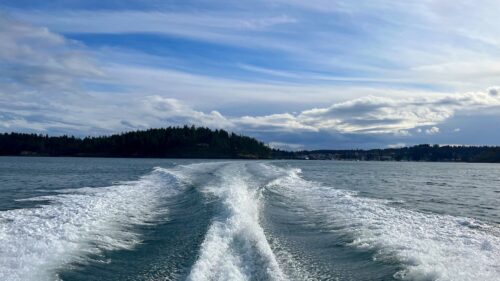
The waters of the San Juan Islands
Those breathtaking views were on the mind of Jay Julius W’tot Lhem, Se’Si’Le founder and president and former Lummi tribal chairman, when we spoke to him the next morning in Friday Harbor. He told us of his wish for newcomers to the Coast Salish territories to understand how the landscapes we found so beautiful are a source of immense grief for Jay and other tribal people of the region. To understand this grief, Jay said, we must all learn to look to the past.
Later, we walked with Jay as he paced the 500-foot length of a now absent Coast Salish longhouse that once stood at the shore of what is now known as Garrison Bay on the northwest side of San Juan Island. This place, a national historic park now known as English Camp, is full of historical relics, but this history reflects only the military colonial moment that began in the 1800s.
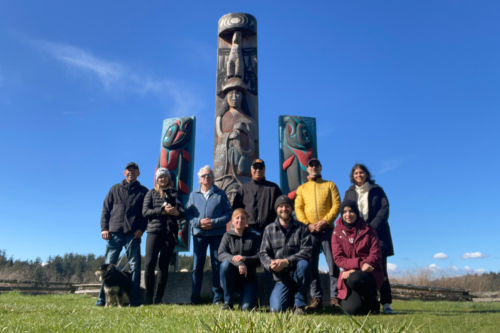
The ESI team and our friends and partners at the totem pole sculpture in “English Camp.” Standing: Jay Julius W’tot Lhem, Jessica Newley, Kurt Russo, Dana Wilson, John Fernández, Supreetha Krishnan. Kneeling: Briana Meier, John Vechey, Norhan Bayomi
Our group that morning included John Vechey, founder and president of Pluto VR, who enlisted us to capture images of a contemporary totem pole sculpture—the single structure on the site representing thousands of years of Coast Salish heritage. John Vechey and Se’Si’Le plan to use these images in a new virtual reality exhibit in Friday Harbor that will introduce visitors to this all-too-often erased history.
ESI, Se’Si’Le, and Pluto VR are partnering to develop virtual reality designs to share ancestral knowledges in service to protecting and restoring sustainable ways of living with the Earth. We believe that immersive experiences like the VR exhibit in Friday Harbor can be powerful tools for building empathy and solidarity with the loss and struggles of tribal peoples in the region—for transmitting the simultaneous experience of beauty and grief present in the landscape today.
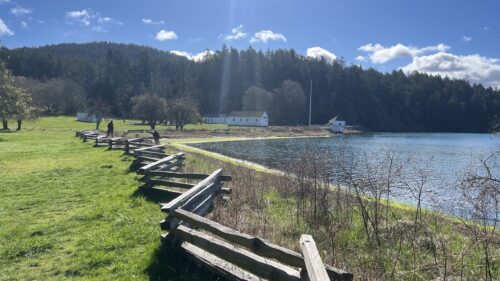
The national historical park now known as “English Camp” on the site of a former Coast Salish village
In the coming months, The Climate Machine—Bayomi and Krishnan’s program combining art, technology, and climate stories—will partner with two students from ESI’s Rapid Response Group to develop a visual narrative for a “Journey Through Time,” an audio-reactive visualizer that narrates an experience of climate change impacts over time. The visualizer will be developed using a combination of AI-generative art and original visual media. It will tell the story of orca populations in the San Juan Islands in a changing climate, and the relationship between the Coast Salish peoples, the orcas, and their traditional lands and waters. This visualizer will be the seed for a larger immersive experience that combines VR and AR.
This summer, I am leading a second Rapid Response Group student team in partnership with Se’Si’Le and other Pacific Northwest nonprofit organizations that are working to restore the Snake River and protect salmon, orcas, and treaty rights. This fall, we will conduct field research during a series of public events led by Se’Si’Le and intended to raise awareness about these issues.
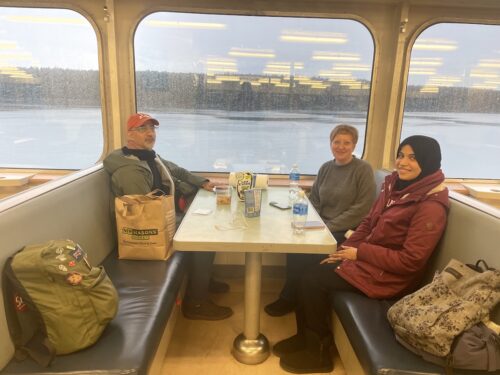
John Fernández, Briana Meier and Norhan Bayomi on the ferry through the San Juan Islands
Se’Si’Le, led by Jay Julius and Dr. Kurt Russo, joins us as a critical partner in the ESI Climate Justice Program’s efforts to integrate Indigenous ancestral knowledges into MIT’s climate action work and support climate justice for Indigenous communities. Our partnership was sparked during Se’Si’Le’s first visit to MIT in April 2022 for the Living Climate Futures symposium and our first visit to Friday Harbor in July 2022. Our April 2023 trip has launched a new phase of the partnership. We look forward to continued work with Se’Si’Le as we develop the virtual reality heritage experience, the Climate Justice Program, and plan for an Indigenous Climate Justice Forum at MIT in 2023-2024.
Preparing Colombia’s cities for life amid changing forests
ESI Research Program Director Marcela Angel has built an international program in natural climate solutions. Read the full story in MIT News.
Tracing heat and flood risk in Boston
June 1, 2023
As climate change exposes cities to more frequent extreme heat and flooding events, city planners and local leaders are looking for more detailed information on neighborhood-level risks to help prepare for disaster. In ESI director John Fernández’s Urban Metabolism Group, recent MIT graduates Katherine Xu and Anushka Ray have developed a new tool to perform these analyses swiftly and using publicly available data.
The project was organized by ESI Postdoctoral Associate Norhan Bayomi, who wanted to explore using computer vision to create city-wide maps of heat and flood risk. Bayomi had pursued this kind of risk mapping on individual buildings, using image data from drones—now she wanted to see if wider-resolution images could apply a similar approach to entire cities. Xu and Ray, both master’s students focusing on artificial intelligence in the Department of Electrical Engineering and Computer Science, responded to the call.
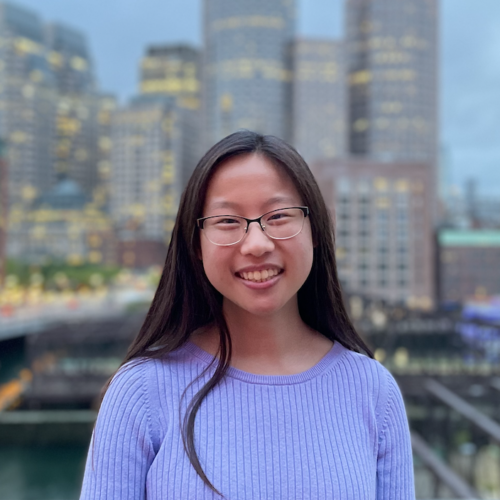
Katherine Xu ’22, M.Eng. ’23
“I specifically was really interested in how this opportunity would combine artificial intelligence, which has been my background, with a problem for social good—actually being able to use AI to solve these critical challenges,” says Xu, now a PhD student in computer science at the University of Pennsylvania.
“When we first got in, the project was pretty broad,” adds Ray, who now works on artificial intelligence projects at Microsoft. “We narrowed it down to using image segmentation techniques to segment aerial images, and link that to flood and heat risk.”
“Image segmentation” is the ability to break down an image into the different types of objects being depicted. Our brains do this automatically—picking out a tree here, a brick wall there—but a computer has to be trained. “What we did was segment aerial images, like what you see in Google Maps or Apple Maps,” says Ray. “So the classes that we were interested in were trees, grass, roads, sidewalks, soil, and then buildings and water. And for each image, we were able to train a model to find those areas with pretty good accuracy.”
This information is relevant to heat and flood risk because these different terrains can provide shade, evaporative cooling and water absorption on the one hand, or hot surfaces and places for water to pool on the other. Working with aerial images of Boston, the student team manually labeled each pixel until they’d built a large enough dataset for their model to segment new images on its own.
“Which is good, because the land cover for a specific area can change over time,” says Xu. “We want this segmentation model to be able to adapt,” changing its estimates of risk as trees are planted or parks are paved.

Anushka Ray ’22, M.Eng. ’23
But aerial images provide only very partial information on the factors that determine whether a street will flood or an apartment building will bake. Xu, who worked on the heat risk portion of the project, also brought in records of Boston surface temperatures; Ray, working on flood risks, layered in a map of slope and elevation.
And both concentrated on the human aspects of the environment as well. The Boston Buildings Inventory, maintained by the city government, allowed them to add information about building age and height, and how much air conditioning was available; and the American Community Survey, taken annually by the U.S. Census Bureau, lets the model see what percentage of each census tract falls into more vulnerable groups like those with low incomes, disabilities, or those under age 6 or over age 65.
Combining these factors required some judgment calls, and Ray and Xu consulted the past literature on heat and flood risks to assign a “weight” to each of their variables. After evaluating every factor, the models create maps of risk down to individual census tracts—small areas of about 4,000 residents each.
To validate that these risks are accurate, Ray and Xu compared it to other maps created with different techniques. For flooding, they consulted the Climate Ready Boston map produced by the city. “I saw that for all of the census tracts that have high risk in my model, they were also predicted on the map to experience coastal flooding or storm water flooding at some point in the future,” says Ray. Xu found similar results comparing her model’s heat risk predictions to those in Risk Factor, a tool created by the nonprofit First Street Foundation.
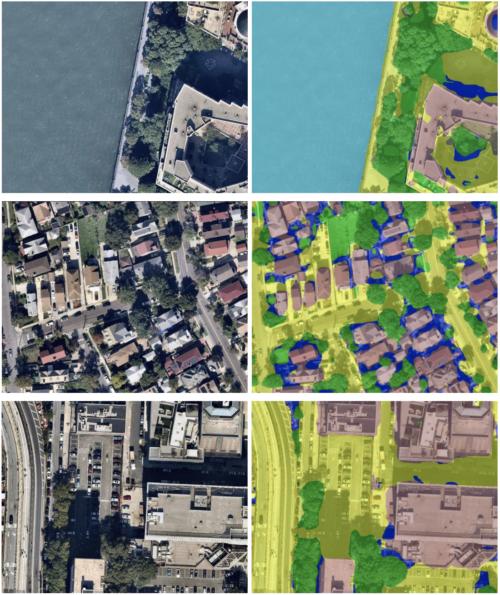
The model takes aerial image data (left) and segments it into different types of terrain relevant to heat and flood risk (right). These images come from New York City, which the model successfully segmented after training on Boston data.
There are also hints in the city’s design and planning that can help validate the model. “For example, we would expect to see that census tracts that have the highest heat risk would also be closest to the cooling centers,” says Xu. “So I went to the City of Boston website, and I was able to find a map of all of the cooling centers in Boston. What I found here is that all the top 10 census tracts from my model are within a 10-minute walk of one of these cooling centers.”
The new tool this team built is just one of several estimating climate risks in cities, but the combination of image segmentation with publicly accessible data does give it some unique advantages. “As long as we have the aerial images for a specific region, we’re able to very quickly extract the segmentation images,” says Xu. “This would be helpful in the case where we might see the land cover for an area changing over time, or if we want to adapt our heat risk or flood risk models to other cities.”
And the team has already demonstrated that the imaging portion of the model can capably handle new cities, quickly generating a map of New York City that parcels out the different types of terrain.
It’s an important first step toward making a model that can map climate risks all around the country—without having to collect brand-new data or rethink risk factors from the ground up with each new city looking to understand where it needs to adapt.
Six ways MIT is taking action on climate
A variety of recent events, several hosted or co-hosted by ESI, highlighted efforts by MIT faculty, staff, and students to make a difference today. Read the full story at MIT News.
How can the U.S. safely mine minerals critical to a carbon-free economy?
ESI visiting scientist Scott Odell is among the contributors to a special edition of the Environmental Law Institute’s Environmental Forum on the question, “How can the U.S. safely mine minerals critical to a carbon-free economy?” Read his contribution, “Cooperate Internationally, Reduce Demand,” along with those of his contributors online.